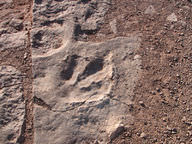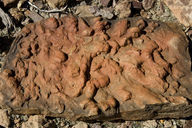15.1: How Fossilization Creates Fossils
- Page ID
- 5575
How do you find fossils?
In lots of places, you can go on a field trip to find fossils. The fossils are found in rock layers. You can break apart the rock layers and find the fossils.
What Are Fossils?
Fossils are preserved remains or traces of organisms that lived in the past. Most preserved remains are hard parts, such as teeth, bones, or shells. Hard parts are less likely to be destroyed before they can become fossils. Even so, a very tiny percentage of living things become fossils. These types of fossils are called body fossils (Figure below, Figure below, and Figure below).
The preserved remains of an ammonite.
The preserved remains of an Archaeopteryx, a type of dinosaur.
A group of preserved trilobites, a variety of ancient marine arthropods.
Preserved traces can include footprints, burrows, or even wastes. Examples of these types of fossils, called trace fossils are picture below (Figure below and Figure below).
The preserved trace of a dinosaur footprint, originally in mud.
A preserved trace: burrows made by prehistoric worms.
Summary
- Fossils are the remains or traces of living organisms.
- Body fossils are usually hard parts, such as bones, teeth, and shells.
- Trace fossils are the traces of organisms, not parts of them. Trace fossils include footprints, feces, and burrows.
Review
- Give three examples of body fossils.
- Give three examples of trace fossils.
- Why are most fossils of hard-bodied organisms?
Explore More
Use the resource below to answer the questions that follow.
- What do paleontologists study and what is that thing?
- At least how old are most fossils?
- What are trace fossils? What are a few examples?
- What can be learned from trace fossils?
- What are mold fossils?
- How do resin fossils?
- What are body fossils?
- How do body fossils form?
- If body fossils form beneath layers of sediment, how do they end up at the surface where they can be found?







